Erectile Dysfunction and vitamin D - many studies
Summary of Erectile Dysfunction and Vitamin D
11,000+ studies of ED and Vitamin D: A good level of Vitamin D (20-50 ng) both prevents and treats
ED about 8X less if good Vitamin D level vs poor level
ED 5% less likely for each 1ng/mL more of Vitamin D in blood - July 2020
Vitamin D not only stops most ED, but also stops the 10 major other diseases that follow ED:
- CVD, Diabetes, Obesity, Metabolic Syndrome, MS, Depression, CKD, COPD, etc
Viagra and Cialis can reduce risk of 10+ health problems if taken several times a week, but have health problems and much higher cost
- Costs for similar benefits: Cialis $300/year, Viagra $12,000/year, Vitamin D $10 a year
The ED is not decreased for about 3-9 months unless Vitamin D is quickly restored
Probably can treat ED in weeks if take 300,000 IU of Vitamin D once or take 50,000 IU daily for a week.
Followed by maintenance dose of 50,000 IU Vitamin D once every two weeks.
11,800 studies of Erectile Dysfunction and Vitamin D - as of April 2025
Example
The relationship between vitamin D levels and erectile dysfunction: A mini-review - Jan 2025
https://doi.org/10.5653/cerm.2024.07402 FREE PDF
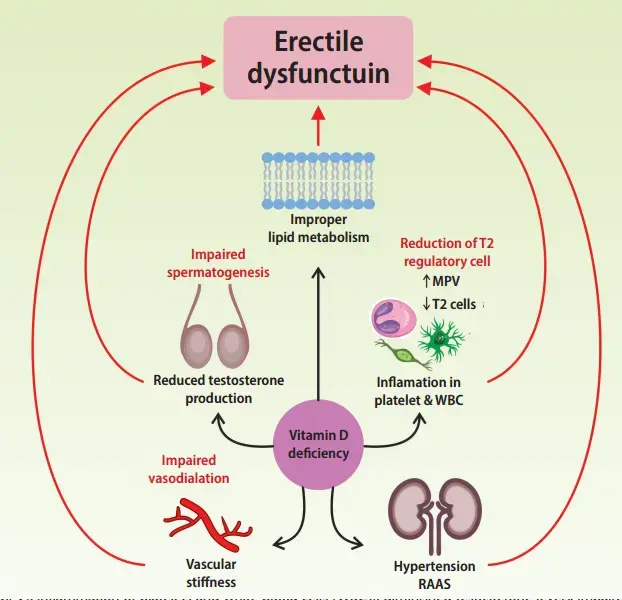
Perplexity AI - Deep Research - April 2025: ED likely treated if vitamin D levels are between 20 and 50 ng/mL
Conclusion
The preponderance of evidence suggests an association between vitamin D deficiency and erectile dysfunction, with multiple plausible biological mechanisms explaining this relationship. Vitamin D appears to influence erectile function through effects on
vascular health,
endothelial function,
nitric oxide production,
hormonal regulation, and
structural maintenance of penile tissues.
While some contradictory findings exist, maintaining optimal vitamin D levels (20-50 ng/mL) may benefit erectile function as part of a comprehensive approach to men's sexual health. Future research should focus on well-designed interventional studies to clarify whether vitamin D supplementation can effectively treat ED in deficient individuals and to establish optimal dosing regimens.
For men experiencing persistent ED, a holistic approach addressing all potential contributing factors—including but not limited to vitamin D status—remains the most prudent clinical strategy. Consultation with healthcare professionals is essential for appropriate diagnosis and tailored therapeutic interventions.
Low Vitamin D causes Erectile Dysfunction (in mice and rats) - April 2025
Vitamin D deficiency induces erectile dysfunction: Role of superoxide and Slpi
Br J Pharmacol . 2025 Apr 13. doi: 10.1111/bph.70034
Miguel A Olivencia 1 2 3, Belén Climent 2 3 4, Bianca Barreira 1 2 3, Daniel Morales-Cano 1 2 3, Ana Sánchez 4, Argentina Fernández 5 6, Borja García-Gómez 7, Javier Romero-Otero 7, Claudia Rodríguez 4, Laura Moreno 1 2 3, Dolores Prieto 4, María Jesús Larriba 8 9 10, Angel Cogolludo 1 2 3, Javier Angulo 5 6, Francisco Perez-Vizcaino 1 2 3
Background and purpose: Epidemiological studies suggest a relationship between vitamin D deficiency and erectile dysfunction (ED). We hypothesized that vitamin D deficiency or vitamin D receptor (VDR) knockout causes ED and analysed the underlying molecular mechanisms.
Experimental approach: Erectile function was assessed in vivo in anaesthetized male mice or rats by evaluating intracavernosal pressure (ICP) and in vitro in male Vdr-/- mice, and rat or human isolated corpora cavernosa (CCs) mounted in a myograph. Bulk RNA-sequencing (RNA-seq) transcriptomic analysis was performed in rat CCs. Vitamin D deficiency was induced in rats fed a vitamin D-free diet for 5 months.
Key results: CCs from human donors with low plasma vitamin D exhibited reduced nitric oxide (NO)-dependent erectile function. This ED was also reproduced in vitamin D-deficient rats and VDR knockout mice , in vivo and ex vivo, and is associated with penile fibrosis and reduced response to the phosphodiesterase 5 inhibitor (PDE5i) sildenafil. CCs from deficient rats show increased superoxide levels, and their impaired erectile function was restored by superoxide scavengers. Transcriptomic analysis, real-time polymerase chain reaction (RT-PCR) and Western blot showed down-regulated secretory leukocyte protease inhibitor (Slpi). Moreover, recombinant SLPI prevented superoxide-induced ED, while Slpi gene silencing led to reduced erectile function in a superoxide-dependent manner.
Conclusion and implications: Vitamin D deficiency or VDR knockout reduces erectile function. We suggest that this effect is mediated by increased superoxide levels and down-regulation of SLPI. Vitamin D deficiency might be an aetiological factor for vascular ED and for the therapeutic failure of PDE5i.
📄 Download the PDF from VitaminDWiki
Two Erectile Dysfunction vs Vitamin D charts
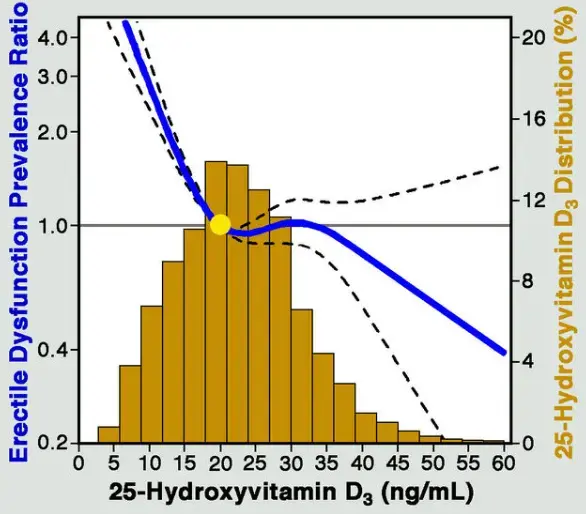
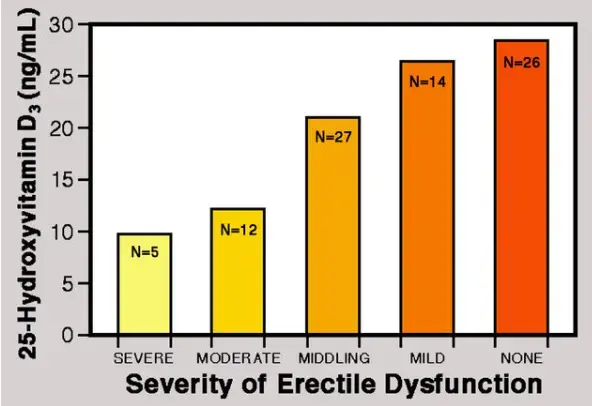
from: Psychology Today - Nov 2020
How Vitamin D might prevent and treat Erectile Dysfunction - June 2023
Mechanisms Suggesting a Relationship between Vitamin D and Erectile Dysfunction: An Overview
Biomolecules 2023, 13(6), 930; https://doi.org/10.3390/biom13060930by Andrea Crafa 1,Rossella Cannarella 1,2,*ORCID,Federica Barbagallo 1,Claudia Leanza 1,Roberto Palazzolo 1,Hunter Ausley Flores 3,Sandro La Vignera 1ORCID,Rosita A. Condorelli 1ORCID andAldo E. Calogero 1ORCID
1 Department of Clinical and Experimental Medicine, University of Catania, 95121 Catania, Italy
2 Glickman Urological & Kidney Institute, Cleveland Clinic Foundation, Cleveland, OH 44195, USA
3 Scott Department of Urology, Baylor College of Medicine in Houston, Houston, TX 77030, USA
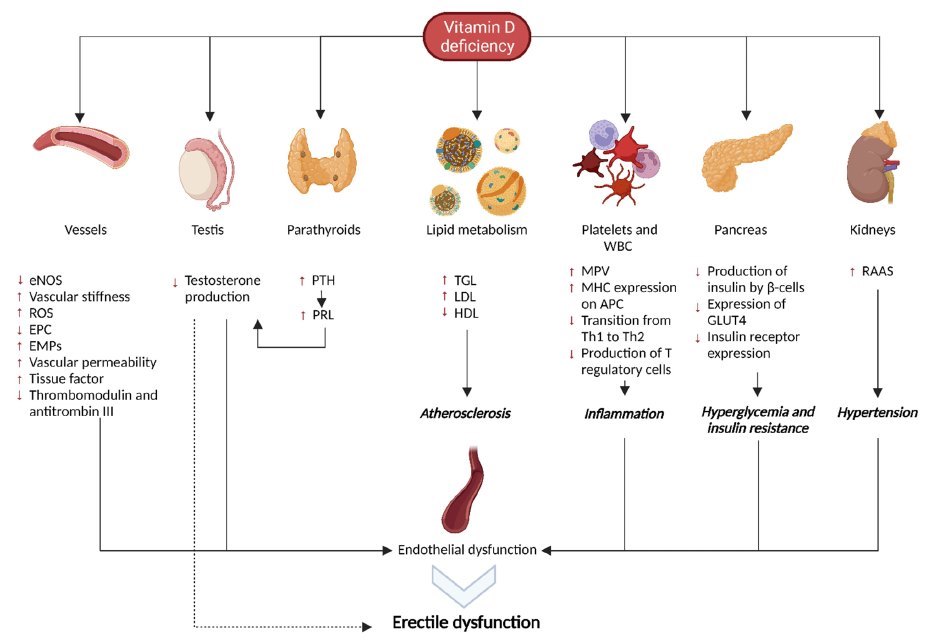
Vitamin D deficiency (VDD) and erectile dysfunction (ED) heavily burden the male population. The higher prevalence of both conditions in the elderly suggests a possible relationship between the two conditions. In addition, in vitro, animal, and human studies have revealed several mechanisms that may relate VDD to ED. The main mechanism by which vitamin D might exert its action on sexual function appears to be through the regulation of endothelial function . Indeed, VDD correlates with several markers of endothelial function. The action of vitamin D on the endothelium would be exercised both indirectly through its intervention in inflammatory processes and through the production of oxygen free radicals, and directly through the regulation of vascular stiffness, the production of nitric oxide, and the regulation of vessel permeability.
Furthermore, the ubiquitous distribution of the vitamin D receptor in the human body means that this hormone can also exert a beneficial effect on erectile function by interfering with those comorbidities significantly associated with ED, such as hypertension, diabetes mellitus, hypercholesterolemia, chronic kidney disease, and hypogonadism.
In this review, we thoroughly and carefully presented the evidence and mechanisms that would appear to relate vitamin D levels to erectile function. Furthermore, we have summarized the meta-analytic evidence for and against this association to provide a true representation of this topic.
Data published to date suggest that low levels of vitamin D could contribute to worsening erectile function through several mechanisms. Therefore, vitamin D levels should be measured in patients with ED and maintained at adequate levels by specific supplementation in case of deficiency. However, the low quality and heterogeneity of clinical trials evaluating the effects of vitamin D administration on erectile function and ED-associated comorbidities do not allow for a univocal conclusion, and indicate the need for further studies to analyze these aspects.
📄 Download the PDF from VitaminDWiki
Both types of erectile dysfunction have low Vitamin D - Dec 2022
The relationship between serum 25-hydroxy vitamin D and arteriogenic erectile dysfunction
Andrologia . 2022 Dec;54(11):e14568. doi: 10.1111/and.14568 publisher rents PDF for $12
Xu Wu 1 , Yuyang Zhang 1 , Wei Zhang 1 , Guodong Liu 1 , Hui Jiang 2 , Houbao Huang 3 , Xiansheng Zhang 1
This study aimed to assess the relationship between 25(OH) levels and erectile dysfunction (ED), particularly arteriogenic ED (A-ED). From September 2020 to January 2022, 150 patients diagnosed with ED by the International Index of Erectile Function-5 (IIEF-5) questionnaire were included. All patients were classified as organic ED and psychological ED by nocturnal penile tumescence and rigidity (NPTR) examination. Organic ED patients were divided into A-ED and NA-ED by penile doppler ultrasound (PDU) examination. Finally, 150 patients complaining of ED were enrolled in our study. 25(OH)D levels were significantly lower in patients with
organic ED (18.24 ± 6.04 ng/ml) than in patients with
psychogenic ED (20.90 ± 8.79 ng/ml) (p = 0.032).
In A-ED and NA-ED, the mean of peak systolic flow velocity (PSV) values was
18.94 ± 5.28 cm/s and
51.57 ± 15.42 cm/s (p < 0.001),
and the mean of 25(OH)D was
15.66 ± 5.86 ng/ml and
20.48 ± 5.90 ng/ml, respectively (p < 0.001).
The results showed that 25(OH)D levels were positively correlated with IIEF-5 scores and the PSV values in A-ED patients.
The 25(OH)D cut-off value differentiating between A-ED and NA-ED was 15.05 ng/ml. Low 25(OH)D levels may be an independent risk factor for ED, especially A-ED. ED patients should routinely undergo serum 25(OH)D level measurement, and 25(OH)D replacement therapy is necessary for patients with low vitamin D levels.
Senior male COVID-19 patients were 13 X more likely to have ED - Nov 2021
Increased odds ratio for erectile dysfunction in COVID-19 patients
Journal of Endocrinological Investigation volume 45, pages 859–864 (2022)
J. Katz, S. Yue, W. Xue & H. Gao

Purpose
Erectile dysfunction and COVID-19 share similar risk factors, including vascular disruption of integrity, cytokine release, cardiovascular disease, diabetes and obesity.
The aim of this study was to investigate the association between erectile dysfunction and COVID-19 patients.
Methods
Odds ratio for erectile dysfunction in patients with a history of COVID-19 with and without comorbidities were calculated using a patients’ registry platform i2b2. ICD-10 diagnoses codes were accessed for queries and data were analyzed using logistic regression.
Results
Patients with COVID-19 were 3.3 times more likely to have erectile dysfunction with 95% CI (2.8, 3.8). The association became stronger with odds ratio 4.8 (95% CI (4.1, 5.7)) after adjusting for age groups.
The odds ratio remained the same after adjusting for smoking status with 3.5 (95% CI (3.0, 4.1)). After adjusting for race, COVID-19 patients were 2.6 (95% CI (2.2, 3.1)) times more likely to have erectile dysfunction. The odds ratio were 1.6, 1.8, 1.9 and 2.3 after adjusting for respiratory disease, obesity, circulatory disease and diabetes, respectively.
Conclusion
COVID-19 and erectile dysfunction are strongly associated even after adjustment for known risk factors and demographics.
📄 Download the PDF from VitaminDWiki
Vitamin D looks like a good way to treat ED - Review Jan 2021
Vitamin D and Male Erectile Function: An Updated Review
World J Mens Health. 2021 Jan; 39(1): 31–37 doi: 10.5534/wjmh.190151
Onder Canguven corresponding author1,2 and Ahmad H. Al Malki1,3
Literature support that vitamin-D is important for different systems of the human body including, but not limited to endocrine and immune systems, vasculature and endothelial function of the body. Male erectile function depends on many factors and can be perceived as a health indicator of the body. Epidemiological data have shown that vitamin-D deficiency is also associated with erectile dysfunction. In this review, our aim is to interpret the mechanisms by which vitamin-D might regulate anatomy and physiology of penis. Evidence showed that vitamin-D is needed for an adequate erectile function. Briefly, vitamin-D is crucial for a better healthy body and sexual activity.
PDF CONCLUSIONS
Based on the evidence from bench and bed, it was shown that VD is important for erectile function. Measurement of VD in ED patients is very crucial with supplementation as required.
VD supplementation potentially represents a low-cost, low-risk method to treat and prevent ED .
In summary, we need VD starting from the early embryonal days to the end of our lives for a better, healthy and sexually active life
📄 Download the PDF from VitaminDWiki
ED is associated with low Vitamin D - meta-analysis May 2020
Is There an Association Between Vitamin D Deficiency and Erectile Dysfunction? A Systematic Review and Meta-Analysis
Nutrients 2020, 12(5), 1411; https://doi.org/10.3390/nu12051411
by Andrea Crafa,Rossella CannarellaORCID,Rosita A. Condorelli *ORCID,Sandro La VigneraORCID and Aldo E. CalogeroORCID
Erectile dysfunction (ED) is found very frequently in the male population, in particular in its arteriogenic form, which also represents an important predictor of cardiovascular diseases (CVDs). Some evidence suggests that vitamin D could play a role in cardiovascular risk prevention thanks to its ability to reduce endothelial damage, oxidative stress, the production of inflammatory cytokines, and dyslipidemia. Since ED and CVDs have pathogenic mechanisms in common, numerous studies have evaluated a possible association between vitamin D deficiency (blood concentrations of 25-hydroxyvitamin D < 20 ng/mL) and ED, but with conflicting results. This meta-analysis was therefore performed to clarify the discrepancy of the data so far published. To achieve this, articles have been searched extensively in the Pubmed, MEDLINE, Cochrane, Academic One Files, Google Scholar, and Scopus databases from the first day they were created until January 2020. The search strategy included pertinent Medical Subjects Headings (MeSH) terms. Of the 431 items retrieved, only eight observational studies were included, resulting in a total sample size of 4055 patients. It was found that 25-hydroxyvitaminD (25(OH)D) levels did not show any significant difference between patients with and without ED. However, when patients with vitamin D deficiency only were taken into account, the international index of erectile function (IIEF) score for erectile dysfunction was significantly worse than in controls. This association remained significant even when eugonadal-only patients were considered.
Finally, we found that eugonadal patients with severe ED have lower 25(OH)D3 levels than patients with mild ED. In conclusion, this meta-analysis suggests an association between vitamin D deficiency and the presence of severe forms of ED, independent of testicular function.
📄 Download the PDF from sci-hub via VitaminDWiki
ED 5% less likely for each 1ng more of vitamin D - July 2020
Novel predictive risk factor of erectile dysfunction: Serum 25-hydroxy vitamin D
Andrologia. 2020 Jul 29;e13767. doi: 10.1111/and.13767
Mustafa Ozan Horsanalı 1, Huseyin Eren 2, Eyup Dil 2, Alper Caglayan 1, Ozgur Erdogan 1, Fatih Ekren 1
📄 Download the PDF from sci-hub via VitaminDWiki
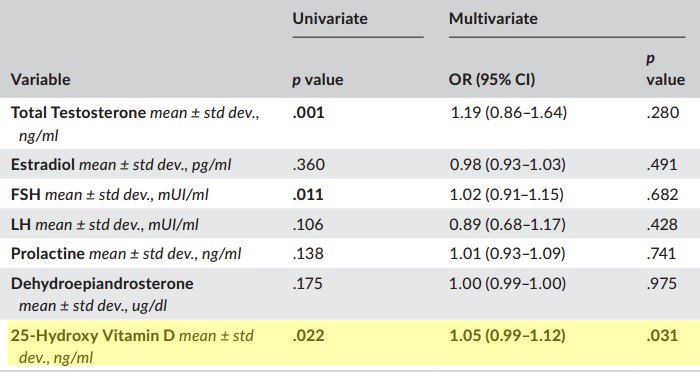
The present study aimed to investigate the association between the severity of erectile dysfunction (ED) and serum 25-hydroxy vitamin D. It also sought to determine the cut-off level of serum 25-hydroxy vitamin D for ED. This study included 130 men who had ED between 2018 and 2019. Patients were divided into three groups according to their scores on the international index of erectile function-5 (IIEF-5) Turkish validated short form questionnaire. The serum 25-hydroxy vitamin D results were compared between the groups. The mean age of the patients was 49.28 ± 13.62 years. Groups 1, 2 and 3 included 44 (33.8%) patients with severe ED, 56 (43.1%) patients with moderate ED and 30 (23.1%) patients with mild ED, respectively. Statistical significance was observed between the groups and serum 25-hydroxy vitamin D levels. A positive correlation was detected between the IIEF-5 scores, serum testosterone and serum 25-hydroxy vitamin D levels.
A cut-off level for serum 25-hydroxy vitamin D was calculated as 27.32 ng/ml. During multivariate analysis, we found that serum 25-hydroxy vitamin D levels were independent prognostic risk factors for decreased IIEF-5 scores. Decreased serum 25-hydroxy vitamin D levels were associated with decreased IIEF-5 scores.
Therefore, vitamin D replacement therapy may improve symptoms.
Lower vitamin D ==> lower Nitric Oxide ==> lower erection - April 2017
The role of vitamin D supplementation on erectile function - Invited Review
Turk J Urol 2017; 43(2): DOI: 10.5152/tud.2017.76032
Raidh A. Talib1,2 riad_talib@yahoo.com, Kareim Khalafalla1, Onder Canguven1-2
'Hamad Medical Corporation, Department of Urology, Doha, Qatar
2Weill Cornell Medical College, Department of Urology, NY, USA
In the last few years growing evidence highlighted vitamin D (VD) deficiency is one of the several dynamics that associates with increased atherosclerotic cardiovascular (ASCV) diseases.
ASCV diseases and erectile dysfunction (ED) share common risk factors such as
diabetes mellitus,
hypertension,
smoking,
hyperlipidemia, and a
sedentary lifestyle.
The aim of this review was to summarize current progress in VD research by focusing effect of low VD level on different body systems and erectile function. Here we examine research linking VD deficiency and ED and discuss how VD influences ED and its classic risk factors-factors that also associate to increased ED risk. We also summarize research indicating that VD associates with reduced risk of several nonvascular contributing factors for ED. Available literature demonstrates relatively high rates of low VD serum levels in ED patients. Based on the preclinical and clinical data available in the literature, to date, we infer that VD play a critical role in maintaining erectile function in humans. Nevertheless, this should also be tested through randomized controlled studies on the effect of VD supplementation with larger population.
📄 Download the PDF from VitaminDWiki
Clipped from the PDF
One mechanism linking low VD levels with ED may be via reduced synthesis of NO. Recently Barassi et al demonstrated a higher presence of VDD in arterial ED patients compared with non-arterial-ED patients and a lower serum VD levels in more severe ED patients.[18]
Both observational and interventional studies have established the presence of an association between VD levels and ED. This relation is more than a simple relation, because there are many risk factors (Figure 2) in the etiology of ED which might be directly caused by VDD.
Vitamin D and nitric oxide production
Penis is a vascular organ, and erections have a vascular basis. NO pathway is known to mediate penile erection. NO is a physiologic signal essential for penile erection, and disorders that reduce NO synthesis or release in the erectile tissue are commonly associated with ED. Sexual stimulation releases neurotransmitters from the corpus cavernosa as well as NO from the endothelial cells of the penis.[17]
Another important mechanism of action of VD seems to be via NO- mediated vascular dilation. NO synthases are a family of enzymes that catalyze the production of NO from L -arginine. Activated VD stimulates the production of substantial quantities of NOS and NO in macrophages produced in bone and in endothelial cells in response to tuberculosis. NO is vital to vascular dilation and thereby important for the inhibition of ED.[17] Because of the presence of VD and VDR in the endothelial cells and the pivotal role of NO and eNOS in the endothelial activity, it is conceivable that an interaction between VD and NO is capable of influencing vascular function.[51] Molinari et al.[51] demonstrated that VD is able to stimulate NO production in human umbilical vein endothelial cells through eNOS activation. The finding of an involvement of VD in NO production by endothelial cells is quite relevant. NO is an essential molecule and serves multiple functions including vasodilatation and many anti-atherogenic properties. Indeed, dysregulation of eNOS activity is thought to contribute to the pathogenesis of certain vascular diseases such as atherosclerosis and hypertension.
Activated VD stimulates the production of NO in endothelial cells and NO synthases which catalyze the production of NO from L-arginine[51], is a key to vascular dilation and thereby critical for the prevention of ED. Interestingly, the latter study showed that VD response occurs within seconds and, for this reason, it appears that VD has a non-genomic direct effect on endothelial cells. Recently, Andrukhova et al.[52] reported that VD receptor mutant mice are characterized by lower bioavailability of the vasodilator NO due to reduced expression of the key NO synthesizing enzyme i.e. eNOS. Reduction in eNOS ends with endothelial dysfunction, increased arterial stiffness, increased aortic impedance, structural remodeling of the aorta, and impaired systolic and diastolic heart function at advanced ages, independent of changes in the renin-angiotensin system.[52] The latter group demonstrated that VD is a direct transcriptional regulator of eNOS.[52] This may also clarify why endothelium derived, and NO-evoked dilation is reduced nearly 50% in arteries from VD deficient male rats.[16] Under the light of recent scientific researches, unsurprisingly, there exists a higher prevalence of ED among VD deficient patients compared to those with optimal levels.[9]
Erectile dysfunction is 1.3X more likely if low vitamin D - July 2016
Vitamin D deficiency is independently associated with greater prevalence of erectile dysfunction:
The National Health and Nutrition Examination Survey (NHANES) 2001–2004
Atherosclerosis in press, doi:10.1016/j.atherosclerosis.2016.07.921
Youssef M.K. Faraga, b, Eliseo Guallara, Di Zhaoa, Rita R. Kalyanic, Michael J. Blahad, David I. Feldmand, e, Seth S. Martind, Pamela L. Lutseyf, Kevin L. Billupsg, Erin D. Michosa, d, ,


Highlights
Both Vit D deficiency and ED have been linked to increased cardiovascular risk.
We found in a representative sample of U.S. men that both Vit D deficiency and ED were common, with prevalence of 30% and 15%, respectively.
We found Vit D deficiency was independently associated with an increased prevalence of ED after accounting for multiple lifestyle and vascular risk factors.
Additional research is needed to evaluate whether treating Vit D deficiency improves erectile function.
Background and aims: Erectile dysfunction (ED) and atherosclerotic cardiovascular disease (ASCVD) share many common risk factors, and vascular ED is a marker for increased ASCVD risk. Low 25-hydroxyvitamin D [25(OH)D] concentrations have been associated with increased ASCVD risk, but less is known regarding the relationship of low 25(OH)D with ED. We determined whether 25(OH)D deficiency is associated with ED independent of ASCVD risk factors.
Methods: We performed cross-sectional analyses of 3390 men aged ≥20 years free of ASCVD who participated in NHANES 2001–2004. Serum 25(OH)D was measured by the DiaSorin radioimmunoassay; deficiency was defined as levels <20 ng/ml (<50 nmol/L). Self-reported ED, assessed by a single validated question, was defined as men who reported being “never” or “sometimes able” to maintain an erection. We assessed the relationship between 25(OH)D deficiency and ED prevalence using adjusted Poisson regression methods.
Results: After accounting for NHANES sampling, the weighted prevalence of 25(OH)D deficiency and of ED were 30% and 15.2%, respectively. 25(OH)D levels were lower in men with vs. those without ED (mean 22.8 vs 24.3 ng/mL, respectively; p = 0.0005). After adjusting for lifestyle variables, comorbidities, and medication use, men with 25(OH)D deficiency had a higher prevalence of ED compared to those with levels ≥30 ng/ml (Prevalence Ratio 1.30, 95% CI 1.08–1.57).
Conclusion: In this cross-sectional analysis of a representative sample of U.S. men, vitamin D deficiency was associated with an increased prevalence of ED independent of ASCVD risk factors. Additional research is needed to evaluate whether treating vitamin D deficiency improves erectile function.
ED associated with CVD, Diabetes, Obesity, Metabolic Syndrome, MS, Depression, CKD, COPD, etc (all associated with low Vitamin D)
Perplexity AI - Deep Research Report April 2025
📄 Download the PDF from VitaminDWiki
Osteoporosis 2.6 X more likely if ED - meta-analysis June 2021
Medicine (Baltimore). 2021 Jun 18; 100(24): e26326. doi: 10.1097/MD.0000000000026326
"The meta-analysis results showed that the risk of osteoporosis in the ED group was significantly higher than that in the non-ED group [odds ratio ( OR = 2.66 , 95% confidence interval (95% CI) 1.42 to 4.98, P= .002, I2= 68%]. "
📄 Download the PDF from VitaminDWiki
Independent marker for ED in Diabetics = low vitamin D level - Jan 2016
Hypovitaminosis D is associated with erectile dysfunction in type 2 diabetes
Endocrine, pp 1-8, First online: 12 January 2016
Nicola Caretta , Saula Vigili de Kreutzenberg, Umberto Valente, Gabriella Guarneri, Alberto Ferlin, Angelo Avogaro, Carlo Foresta
📄 Download the PDF from VitaminDWiki
Diabetes is an established risk factor for erectile dysfunction (ED). The pathophysiology of ED in diabetic men is multifactorial, but it mainly involves a vascular disorder related to a reduction of endothelial function. Recently, several studies have correlated ED risk factors with vitamin D deficiency. In this study, we evaluate the relationship between 25-hydroxyvitamin D [25(OH)D] levels, erectile dysfunction, and vascular disease, in type 2 diabetes mellitus men (T2DM). In this observational study, 92 T2DM males (58.83 ± 9.73 years) underwent medical history collection, International Index of Erectile Function (IIEF-5) questionnaire, that allows the identification and grading of DE, physical examination, biochemical/hormonal blood tests, and penile echo-color Doppler ultrasonography. T2DM patients with lower 25(OH)D levels (<25 nmol/l) showed higher penile IMT (p < 0.05), waist circonference (p < 0.05), glucose concentrations (p < 0.05), and lower IIEF-5 score (p < 0.005), testosterone concentrations (p < 0.05), and cavernous peak systolic velocity (PSV) (p < 0.05), compared to patients with 25(OH)D >50 nmol/l. 25(OH)D levels were directly correlated with IIEF-5 (R = 0.39; p = 0.0001), testosterone (R = 0.24; p = 0.02), and PSV (R = 0.24; p = 0.04) and inversely with waist (R = −0.33; p = 0.002), HbA1c (R = −0.22; p = 0.03), triglyceride (R = −0.21; p = 0.06), and penile IMT (R = −0.30; p = 0.009). At multivariate analysis, 25(OH)D deficiency remained an independent predictor of DE . We demonstrate a significant association between 25(OH)D deficiency and erectile dysfunction in T2DM men. This association may be due to the influence of 25(OH)D deficiency on cardiovascular risk factor (glycaemia, HDL cholesterol, and triglycerides), testosterone plasma levels and endothelial dysfunction.
Erectile Dysfunction is an early indicator of Heart problems (both associated with low Vitamin D) - Nov 2023
The easy way to talk about penises MDEdge

"I tell them it’s a 4-number scale.
A “1” is no erection at all.
A “2” is when it gets harder and larger, but it’s not going to penetrate.
A “3” will penetrate, but it’s pretty wobbly.
A “4” is that perfect cucumber–porn star erection that everyone is seeking.
I have the patient tell me a story. They may say, “When I wake up in the morning, I’m at a 2. When I stimulate myself, I can get up to a 3. When I’m with my partner, sometimes I can get up to a 4.”
Can We Consider Erectile Dysfunction as an Early Marker of Cardiovascular Disease? - June 2023 FREE PDF
"Nowadays, the correlation between ED and CV disease has been widely demonstrated, and ED often precedes CV events and can be used as an early marker to identify men at high risk of major CV disease"
ED and depression are both associated with Low Vitamin D, but so what - Jan 2019
A bone to pick with vitamin D deficiency and erectile dysfunction
International Journal of Impotence Research (2019), https://doi.org/10.1038/s41443-018-0100-0
Levi Charles Holland & Joseph Scott Gabrielsen
PDF is available free at Sci-Hub
Primarily commenting on
The effect of low vitamin D status on sexual functioning and depressive symptoms in apparently healthy men: a pilot study.
Int J Impot Res. 2018;30:224–913 https://doi.org/10.1038/s41443-018-0100-0
Krysiak R, Szwajkosz A, Okopień B.
See also VitaminDWiki
Hypothesis: increased vitamin D will increase erections and decrease CVD – June 2012
Hypothesis – Fatigue the day after sex is due to deficiency of Vitamin D, Magnesium, and Zinc
Vitamin D associations with erectile dysfunction - April 2012
Fertility and Sperm category listing has items along with related searches
